

Compact Muon Solenoid
LHC, CERN
| CMS-PAS-BPH-13-008 | ||
| Precision lifetime measurements of b hadrons reconstructed in final states with a J/ψ meson | ||
| CMS Collaboration | ||
| May 2017 | ||
|
Abstract:
We present measurements of the lifetimes of the B0, B0s, Λ0b, and B+c hadrons using the decay channels B0→J/ψK∗(892)0, B0→J/ψKS, B0s→J/ψπ+π−, B0s→J/ψϕ(1020), Λ0b→J/ψΛ0, and B+c→J/ψπ+. The data sample, corresponding to 19.7 fb−1, was collected from proton-proton collisions at √s= 8 TeV using dedicated triggers to select oppositely charged muons in the J/ψ mass region. The lifetimes times the speed of light are measured to be cτB0= 453.0 ± 1.6 (stat) ± 1.5 (syst) μm (in J/ψK∗(892)0), cτB0= 457.8 ± 2.7 (stat) ± 2.7 (syst) μm (in J/ψKS), cτB0s= 504.3 ± 10.5 (stat) ± 3.7 (syst) μm (in J/ψπ+π−), cτB0s= 443.9 ± 2.0 (stat) ± 1.2 (syst) μm (in J/ψϕ(1020)), cτΛ0b= 443.1 ± 8.2 (stat) ± 2.7 (syst) μm, cτB+c= 162.3 ± 8.2 (stat) ± 4.7 (syst) ± 0.1 (τB+) μm, where the first uncertainty is statistical and the other is systematic. All results are in agreement with the current world average values. | ||
|
Links:
CDS record (PDF) ;
inSPIRE record ;
CADI line (restricted) ;
These preliminary results are superseded in this paper, EPJC 78 (2018) 457. The superseded preliminary plots can be found here. |
||
| Figures | |
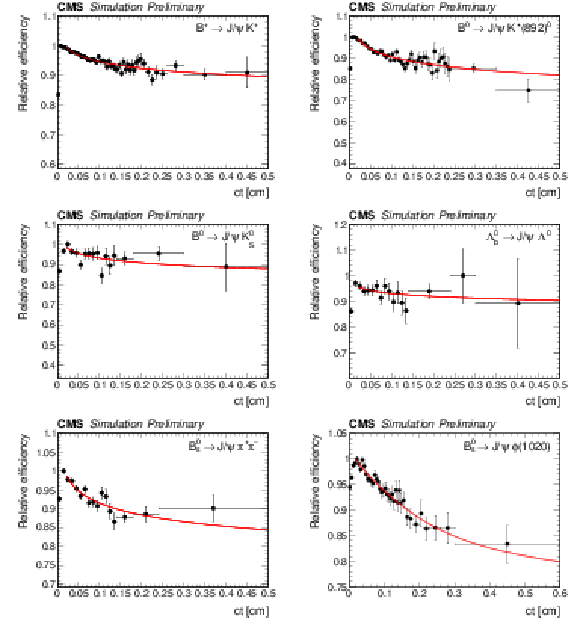
png pdf |
Figure 1:
Efficiency versus ct with a superimposed fit to a inverse power function for B+ (top left), B0→J/ψK∗0 (top right), B0→J/ψK0s (center left), Λ0b (center right), B0s→J/ψπ+π− (bottom left), and B0s→J/ψϕ(1020) (bottom right). The efficiency scale is arbitrary. |
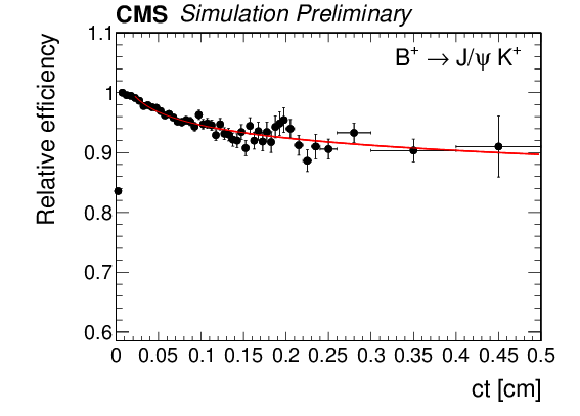
png pdf |
Figure 1-a:
Efficiency versus ct with a superimposed fit to a inverse power function for B+. The efficiency scale is arbitrary. |
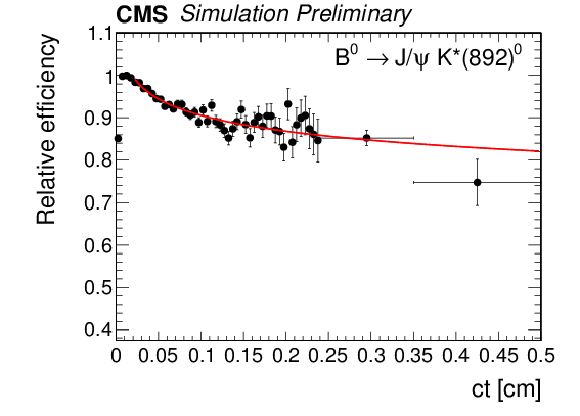
png pdf |
Figure 1-b:
Efficiency versus ct with a superimposed fit to a inverse power function for B0→J/ψK∗0. The efficiency scale is arbitrary. |

png pdf |
Figure 1-c:
Efficiency versus ct with a superimposed fit to a inverse power function for B0→J/ψK0s. The efficiency scale is arbitrary. |
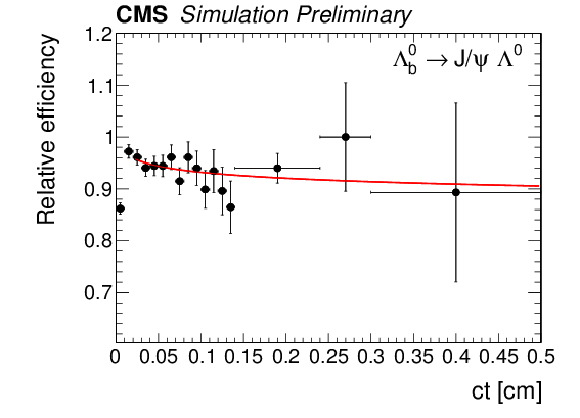
png pdf |
Figure 1-d:
Efficiency versus ct with a superimposed fit to a inverse power function for Λ0b. The efficiency scale is arbitrary. |
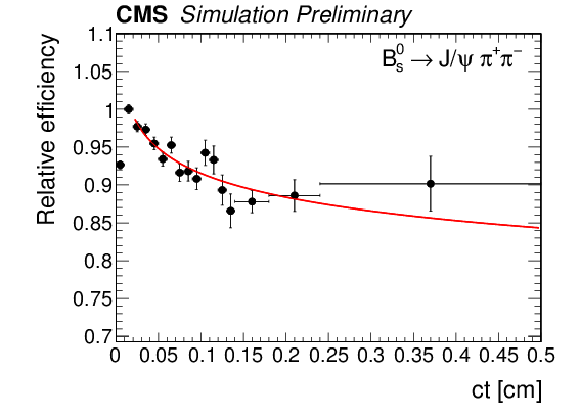
png pdf |
Figure 1-e:
Efficiency versus ct with a superimposed fit to a inverse power function for B0s→J/ψπ+π−. The efficiency scale is arbitrary. |
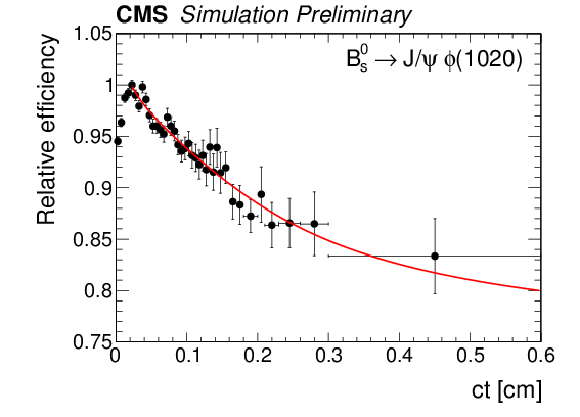
png pdf |
Figure 1-f:
Efficiency versus ct with a superimposed fit to a inverse power function for B0s→J/ψϕ(1020). The efficiency scale is arbitrary. |

png pdf |
Figure 2:
Invariant mass (left) and ct (right) distributions for B+ candidates. The curves are projections of the maximum-likelihood fit to the data, with the contributions from signal (dashed), background (dotted), and the sum of signal and background (solid) shown. The bottom panel of the right figure shows the difference between the observed data and the fit divided by the data uncertainty. |
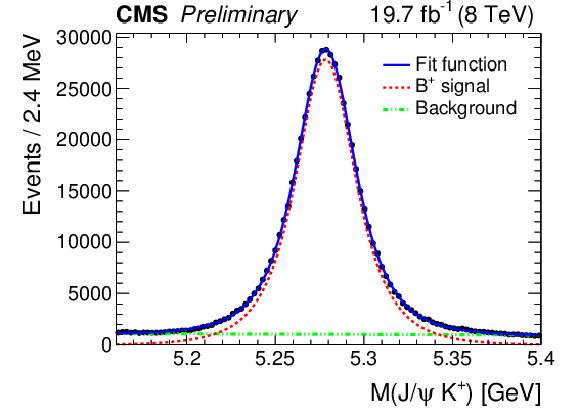
png pdf |
Figure 2-a:
Invariant mass distribution for B+ candidates. The curves are projections of the maximum-likelihood fit to the data, with the contributions from signal (dashed), background (dotted), and the sum of signal and background (solid) shown. |
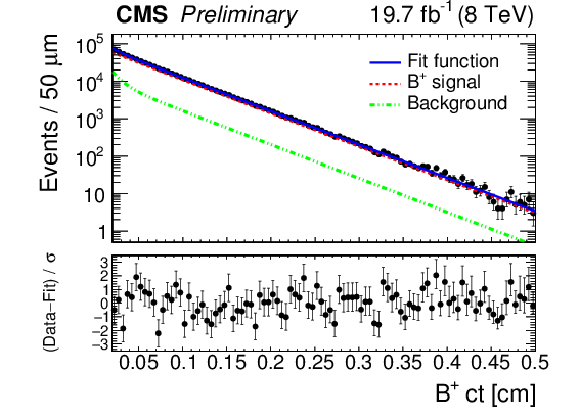
png pdf |
Figure 2-b:
ct distribution for B+ candidates. The curves are projections of the maximum-likelihood fit to the data, with the contributions from signal (dashed), background (dotted), and the sum of signal and background (solid) shown. The bottom panel shows the difference between the observed data and the fit divided by the data uncertainty. |
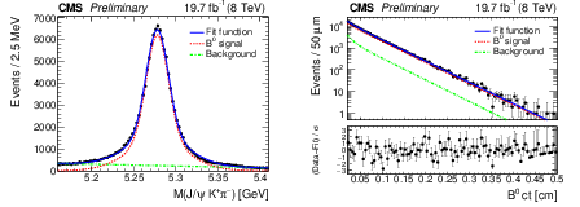
png pdf |
Figure 3:
Invariant mass (left) and ct (right) distributions for B0 candidates reconstructed from J/ψK∗0 decays. The curves are projections of the maximum-likelihood fit to the data, with the contributions from signal (dashed), background (dotted), and the sum of signal and background (solid) shown. The bottom panel of the right figure shows the difference between the observed data and the fit divided by the data uncertainty. |

png pdf |
Figure 3-a:
Invariant mass distribution for B0 candidates reconstructed from J/ψK∗0 decays. The curves are projections of the maximum-likelihood fit to the data, with the contributions from signal (dashed), background (dotted), and the sum of signal and background (solid) shown. |

png pdf |
Figure 3-b:
ct distribution for B0 candidates reconstructed from J/ψK∗0 decays. The curves are projections of the maximum-likelihood fit to the data, with the contributions from signal (dashed), background (dotted), and the sum of signal and background (solid) shown. |
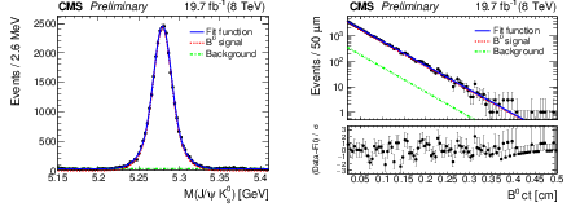
png pdf |
Figure 4:
Invariant mass (left) and ct (right) distributions for B0 candidates reconstructed from J/ψK0s decays. The curves are projections of the maximum-likelihood fit to the data, with the contributions from signal (dashed), background (dotted), and the sum of signal and background (solid) shown. The bottom panel of the right figure shows the difference between the observed data and the fit divided by the data uncertainty. |
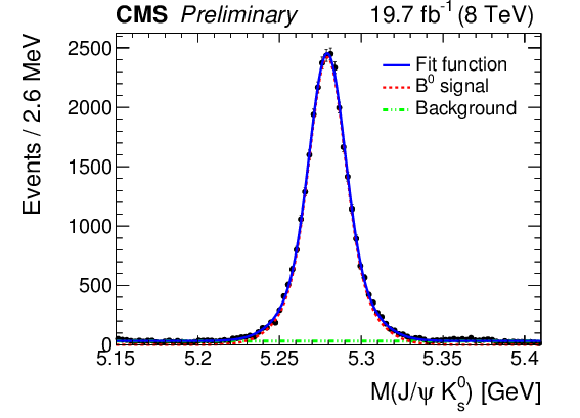
png pdf |
Figure 4-a:
Invariant mass distribution for B0 candidates reconstructed from J/ψK0s decays. The curves are projections of the maximum-likelihood fit to the data, with the contributions from signal (dashed), background (dotted), and the sum of signal and background (solid) shown. |
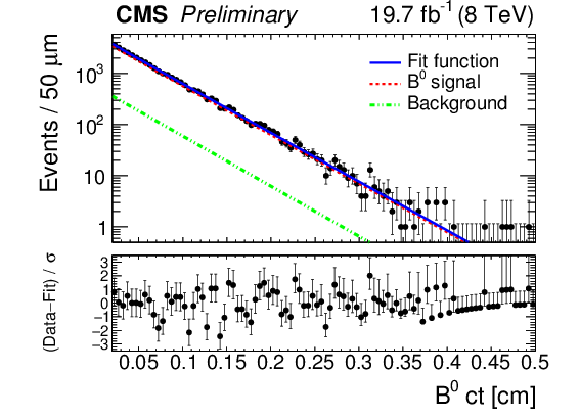
png pdf |
Figure 4-b:
ct distribution for B0 candidates reconstructed from J/ψK0s decays. The curves are projections of the maximum-likelihood fit to the data, with the contributions from signal (dashed), background (dotted), and the sum of signal and background (solid) shown. The bottom panel of the right figure shows the difference between the observed data and the fit divided by the data uncertainty. |
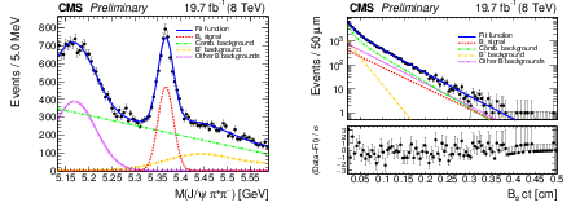
png pdf |
Figure 5:
Invariant mass (left) and ct (right) distributions for B0s candidates reconstructed from J/ψπ+π− decays. The curves are projections of the maximum-likelihood fit to the data, with the contributions from signal (dashed), combinatorial background (dotted), misidentified B+→J/ψK+ background (dashed-dotted), partially reconstructed and (other) misidentified B backgrounds (vertical dashed), and the sum of signal and backgrounds (solid) shown. The bottom panel of the right figure shows the difference between the observed data and the fit divided by the data uncertainty. |

png pdf |
Figure 5-a:
Invariant mass distribution for B0s candidates reconstructed from J/ψπ+π− decays. The curves are projections of the maximum-likelihood fit to the data, with the contributions from signal (dashed), combinatorial background (dotted), misidentified B+→J/ψK+ background (dashed-dotted), partially reconstructed and (other) misidentified B backgrounds (vertical dashed), and the sum of signal and backgrounds (solid) shown. |

png pdf |
Figure 5-b:
ct distribution for B0s candidates reconstructed from J/ψπ+π− decays. The curves are projections of the maximum-likelihood fit to the data, with the contributions from signal (dashed), combinatorial background (dotted), misidentified B+→J/ψK+ background (dashed-dotted), partially reconstructed and (other) misidentified B backgrounds (vertical dashed), and the sum of signal and backgrounds (solid) shown. The bottom panel of the right figure shows the difference between the observed data and the fit divided by the data uncertainty. |
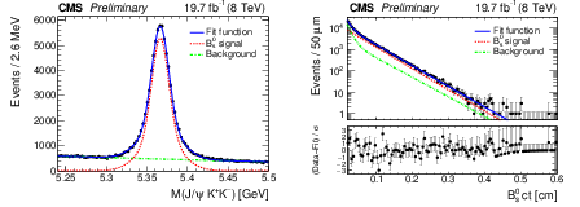
png pdf |
Figure 6:
Invariant mass (left) and ct (right) distributions for B0s candidates reconstructed from J/ψϕ1020 decays. The curves are projections of the maximum-likelihood fit to the data, with the contributions from signal (dashed), background (dotted), and the sum of signal and background (solid) shown. The bottom panel of the right figure shows the difference between the observed data and the fit divided by the data uncertainty. |
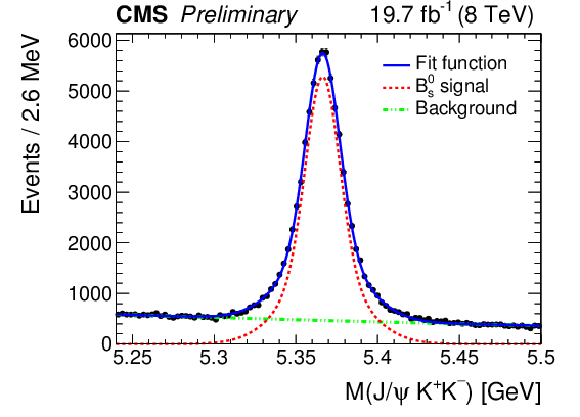
png pdf |
Figure 6-a:
Invariant mass distribution for B0s candidates reconstructed from J/ψϕ1020 decays. The curves are projections of the maximum-likelihood fit to the data, with the contributions from signal (dashed), background (dotted), and the sum of signal and background (solid) shown. |
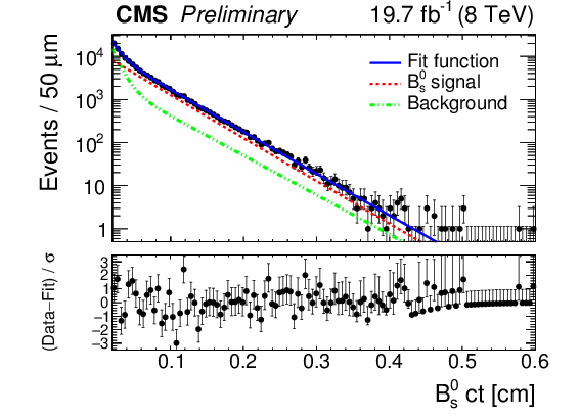
png pdf |
Figure 6-b:
ct distribution for B0s candidates reconstructed from J/ψϕ1020 decays. The curves are projections of the maximum-likelihood fit to the data, with the contributions from signal (dashed), background (dotted), and the sum of signal and background (solid) shown. The bottom panel of the right figure shows the difference between the observed data and the fit divided by the data uncertainty. |
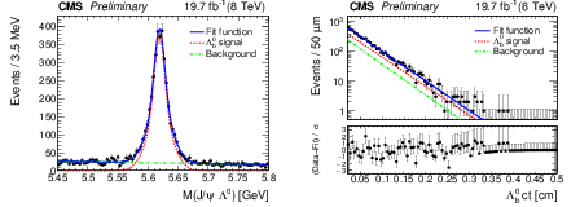
png pdf |
Figure 7:
Invariant mass (left) and ct (right) distributions for Λ0b candidates. The curves are projections of the maximum-likelihood fit to the data, with the contributions from signal (dashed), background (dotted), and the sum of signal and background (solid) shown.The bottom panel of the right figure shows the difference between the observed data and the fit divided by the data uncertainty. |
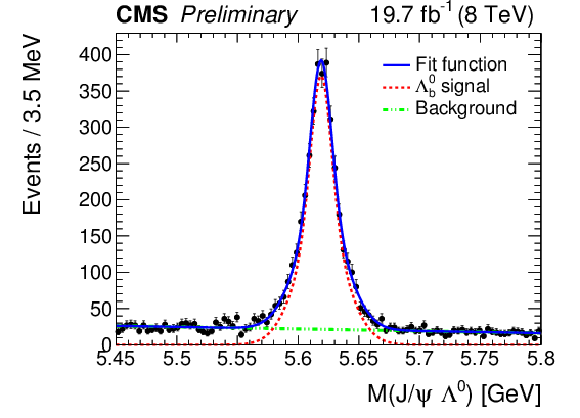
png pdf |
Figure 7-a:
Invariant mass distribution for Λ0b candidates. The curves are projections of the maximum-likelihood fit to the data, with the contributions from signal (dashed), background (dotted), and the sum of signal and background (solid) shown. |
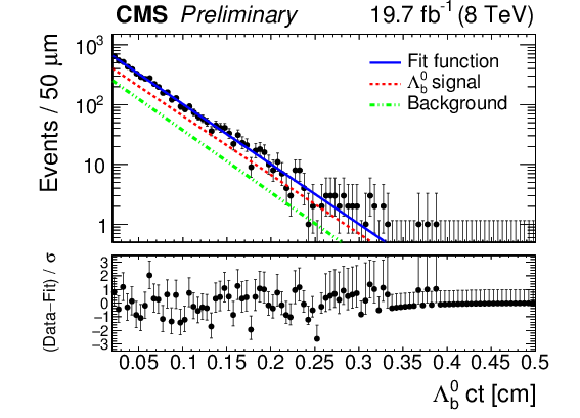
png pdf |
Figure 7-b:
ct distribution for Λ0b candidates. The curves are projections of the maximum-likelihood fit to the data, with the contributions from signal (dashed), background (dotted), and the sum of signal and background (solid) shown.The bottom panel of the right figure shows the difference between the observed data and the fit divided by the data uncertainty. |

png pdf |
Figure 8:
The J/ψπ+ invariant mass distribution (left). The solid line represents the signal-plus-background fit. The dashed line represents the signal component, the dotted line the combinatorial background, and the dashed-dotted line the contribution from Bc→J/ψK+ decays. The J/ψK+ invariant mass distribution (right). The result of the fit is superimposed with a solid line. The signal is shown with a dashed line, the dotted-dashed curves represent the B+→J/ψπ+ and B0 contributions, and the dotted curve the combinatorial background. |
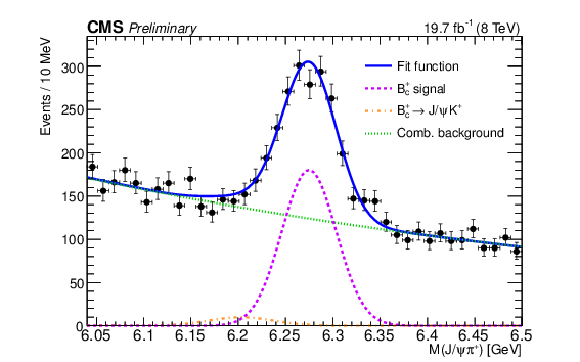
png pdf |
Figure 8-a:
The J/ψπ+ invariant mass distribution. The solid line represents the signal-plus-background fit. The dashed line represents the signal component, the dotted line the combinatorial background, and the dashed-dotted line the contribution from Bc→J/ψK+ decays. |

png pdf |
Figure 8-b:
The J/ψK+ invariant mass distribution. The result of the fit is superimposed with a solid line. The signal is shown with a dashed line, the dotted-dashed curves represent the B+→J/ψπ+ and B0 contributions, and the dotted curve the combinatorial background. |

png pdf |
Figure 9:
The yield (left) of B+c→J/ψπ+ and B+→J/ψK+ events as a function of ct, normalized to the bin width, as determined from fits to the invariant mass distributions. Ratio (right) of the Bc and B+ efficiency distributions as a function of ct. |
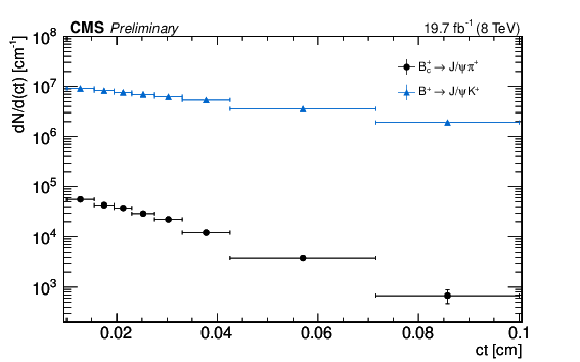
png pdf |
Figure 9-a:
The yield of B+c→J/ψπ+ and B+→J/ψK+ events as a function of ct, normalized to the bin width, as determined from fits to the invariant mass distributions. |
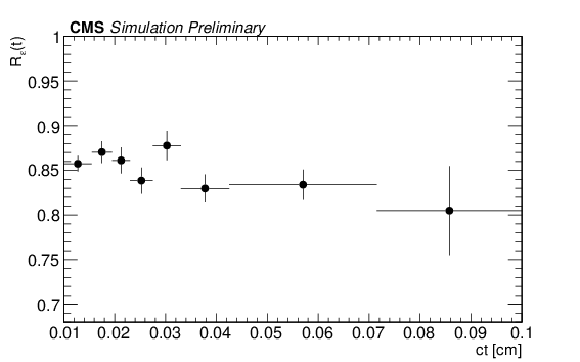
png pdf |
Figure 9-b:
Ratio of the Bc and B+ efficiency distributions as a function of ct. |
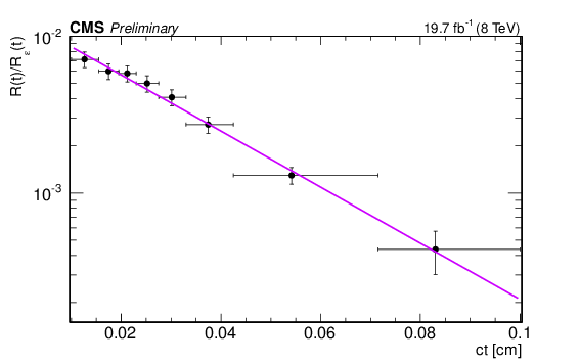
png pdf |
Figure 10:
Ratio of the efficiency-corrected ct distributions for Bc and B+ signals. The line shows the result of fitting with an exponential function. |
| Tables | |
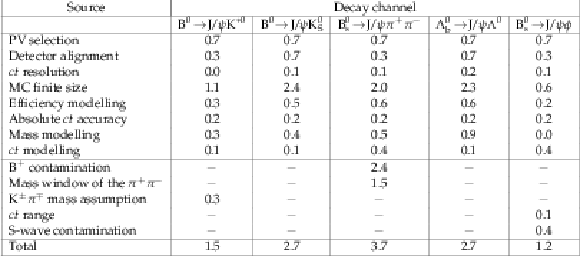
png pdf |
Table 1:
Summary of the systematic uncertainties on the lifetime measurements (in μm). The total systematic uncertainty is the sum in quadrature of all systematic sources. |
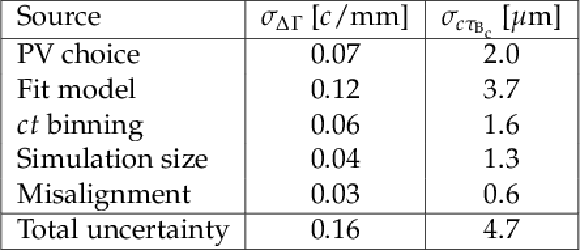
png pdf |
Table 2:
Summary of the systematic uncertainties on the ΔΓ and τBc measurements. |
| Summary |
| The lifetime measurements of the B0, B0s, Bc, and Λ0b hadrons, exploiting the decay channels B0→J/ψK∗0, B0→J/ψK0s, B0s→J/ψπ+π−, B0s→J/ψϕ, Λ0b→J/ψΛ0, and B+→J/ψπ+, have been presented, using proton proton collision events collected by the CMS detector at a centre-of-mass energy of 8 TeV, corresponding to an integrated luminosity of 19.7 fb−1. All measurements are in agreement with the world average values and some are at the precision of the world average of these parameters. |
| References | ||||
| 1 | CMS Collaboration | Prompt and non-prompt J/ψ production in pp collisions at √s= 7 TeV | EPJC 71 (2011) 1575 | CMS-BPH-10-002 1011.4193 |
| 2 | CMS Collaboration | The CMS experiment at the CERN LHC | JINST 3 (2008) S08004 | CMS-00-001 |
| 3 | R. Fleischer and R. Knegjens | Effective lifetimes of Bs decays and their constraints on the B0s-ˉB0s mixing parameters | EPJC 71 (2011) 1789 | 1109.5115 |
| 4 | Particle Data Group, C. Patrignani et al. | Review of particle physics | CPC 40 (2016) 100001 | |
| 5 | LHCb Collaboration | Analysis of the resonant components in ˉB0s→J/ψπ+π− | PRD 86 (2012) 052006 | 1301.5347 |
| 6 | LHCb Collaboration | Measurement of resonant and CP components in ˉB0s→J/ψπ+π− | PRD 89 (2014) 092006 | 1402.6248 |
| 7 | CMS Collaboration | Measurement of the CP-violating weak phase ϕs and the decay width difference ΔΓs using the B0s→J/ψϕ(1020) decay channel in pp collisions at √s= 8 TeV | PLB 757 (2016) 97 | CMS-BPH-13-012 1507.07527 |
| 8 | LHCb Collaboration | Measurement of the B+c meson lifetime using B+c→J/ψμ+νX decays | JHEP 74 (2014) 2839 | 1401.6932 |
| 9 | LHCb Collaboration | Measurement of the lifetime of the B+c meson using the B+c→J/ψπ+ decay mode | PLB 742 (2015) 29 | 1411.6899 |
| 10 | CDF Collaboration | Measurement of the B+c meson lifetime using B+c→J/ψe+νe | PRL 97 (2006) 012002 | hep-ex/0603027 |
| 11 | CDF Collaboration | Measurement of the B−c meson lifetime in the decay B−c→J/ψπ− | PRD. 87 (2013) 011101 | 1210.2366 |
| 12 | D0 Collaboration | Measurement of the lifetime of the B±c meson in the semileptonic decay channel | PRL 102 (2009) 092001 | 0805.2614 |
| 13 | CMS Collaboration | Description and performance of track and primary-vertex reconstruction with the CMS tracker | JINST 9 (2014) P10009 | CMS-TRK-11-001 1405.6569 |
| 14 | T. Sjostrand, S. Mrenna, and P. Z. Skands | PYTHIA 6.4 Physics and Manual | JHEP 05 (2006) 026 | hep-ph/0603175 |
| 15 | C. Chang, C. Driouchi, P. Eerola, and X. Wu | BCVEGPY: an event generator for hadronic production of the Bc meson | CPC 159 (2004) 192--224 | hep-ph/0309120 |
| 16 | J. Chang, C Wang and X. Wu | BCVEGPY2.0: An upgraded version of the generator BCVEGPY with the addition of hadroproduction of the P-wave Bc states | CPC 174 (2006) 241--251 | hep-ph/0504017 |
| 17 | D. Lange | The EvtGen particle decay simulation package | NIMA 462 (2001) 152 | |
| 18 | P. Golonka and Z. Was | PHOTOS Monte Carlo: a precision tool for QED corrections in Z and W decays | Eur.Phys.J.C 45 (2006) 97 | 0506026 |
| 19 | GEANT4 Collaboration | GEANT4: A Simulation toolkit | NIMA 506 (2003) 250 | |
| 20 | CMS Collaboration | Performance of CMS muon reconstruction in pp collision events at √s= 7 TeV | JINST 7 (2012) P10002 | CMS-MUO-10-004 1206.4071 |
| 21 | CMS Collaboration | CMS tracking performance results from early LHC operation | EPJC 70 (2010) 1165 | CMS-TRK-10-001 1007.1988 |
| 22 | LHCb Collaboration | First observation of the decay B+c→J/ψK+ | JHEP 09 (2013) 075 | 1306.6723 |
| 23 | T. Skwarnicki | A staudy of the radiative cascade transitions between the Υ′ and the Υ resonances | PhD thesis, Cracow, INP | |
| 24 | M. J. Oreglia | A Study of the Reactions ψ′→γγψ | PhD thesis, Stanford University, 1980 SLAC Report SLAC-R-236, see Appendix D | |
| 25 | FOCUS Collaboration | Study of the Cabibbo-suppressed decay mode D0→π−π+ and D0→K−K+ | PLB 555 (2003) 167 | |

|
Compact Muon Solenoid LHC, CERN |

|

|

|

|

|

|